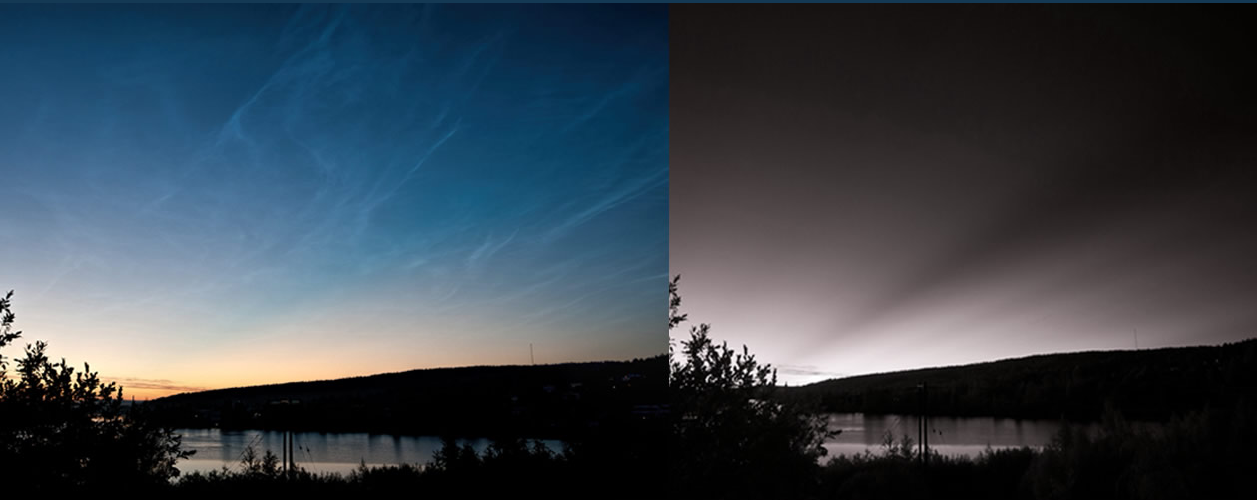NLCs in Infra-red - OPOD
NLCs in Infra-red: A Closer Look at Earth's Highest Clouds
Noctilucent clouds (NLCs) have been captivating skywatchers with their mesmerizing displays over Europe. These ethereal clouds, located at altitudes of 50-53 miles and temperatures below -123 degrees Celsius, are the highest and coldest clouds on Earth. While they do not possess inherent visible light luminosity, they become visible to us through the scattering of sunlight at such high altitudes.
Recently, Roel Wijtmans of Photosynthesis in Nature captured a series of remarkable images of NLCs near Sundsvall in eastern Sweden, just two hours before local sunrise. What makes these images particularly intriguing is that they were taken using both visible light and infra-red cameras. The visible light image showcases the stunning beauty of the NLCs, while the infra-red image reveals something unexpected – the absence of NLCs in the infra-red spectrum.
The difference between the two images provides valuable insights into the composition and nature of NLCs. In the visible light image, we observe that NLCs effectively scatter visible light, giving them their characteristic appearance. However, in the infra-red image, the NLCs appear almost invisible. This disparity suggests that NLC particles scatter near infra-red light far less effectively than they do visible light.
This observation leads us to an important clue about the size of the particles that constitute NLCs. Particles that scatter shorter wavelengths more efficiently than longer wavelengths are known as Rayleigh scatterers. Rayleigh particles are typically smaller than visible light wavelengths. For example, air molecules act as Rayleigh scatterers, and their scattering of light deficient in red gives us our blue skies. Similarly, fine smoke appears blue when viewed at right angles to the light.
Based on this information, it becomes evident that NLCs are composed of minuscule ice crystals, measuring only 0.02-0.1 micron (1 micron = 1/1000 mm) across. These ice crystals are excellent Rayleigh scatterers, effectively scattering visible light and contributing to the blue coloration of NLCs. However, their scattering of near infra-red light is significantly reduced, which explains their almost invisible appearance in the infra-red image captured by Roel Wijtmans.
It is important to note that while the primary reason for the blue color of NLCs is Rayleigh scattering, another process contributes to their hues. Some of the blue coloration observed in NLCs is a result of the absorption of light by ozone in the stratosphere, located far below the NLCs themselves.
By examining NLCs in both visible light and infra-red spectra, researchers and sky enthusiasts gain a deeper understanding of these captivating clouds. The absence of NLCs in the infra-red range suggests that their particles are exceptionally small ice crystals, which efficiently scatter visible light but scatter near infra-red light far less effectively.
As our knowledge of NLCs continues to expand, these unique clouds serve as a reminder of the remarkable phenomena that occur in Earth's atmosphere. Through careful observation and analysis, we can uncover the secrets behind the beauty and behavior of NLCs, shedding light on the mysteries that unfold above us.

NLCs with a Difference ~ The Internet is awash with noctilucent cloud images from recent spectacular displays over Europe. These pictures are different and tell us about the particles that make up Earth's highest clouds. Roel Wijtmans (Photosynthesis in Nature) took them near Sundsvall in eastern Sweden on 11th July two hours before local sunrise. The left-hand picture is in visible light. The right-hand is in infra-red. We see no NLCs in IR! Images ©Roel Wijtmans, shown with permission

NLCs are high (50-53 mile) and cold (>-123 Celsius). They have no intrinsic visible light luminosity and we see them only by the high altitude sunlight that they scatter.
Roels's images show that they scatter visible light but scatter near infra-red far less effectively. This gives a clue to size of the cloud particles. Particles that scatter short wavelengths much more effectively than longer wavelengths are Rayleigh scatterers. Rayleigh particles are smaller than visible light wavelengths. Air molecules are Rayleigh scatterers and their scattered light deficient in red gives us blue skies. Fine smoke is similarly blue at right angles to the light.
In fact, NLCs are composed of miniscule ice crystals only 0.02- 0.1 micron (1micron = 1/1000 mm) across. Excellent Rayleigh scatterers. Some of their blue colour is from another process, absorption by ozone in the stratosphere far below them.

Note: this article has been automatically converted from the old site and may not appear as intended. You can find the original article here.
Reference Atmospheric Optics
If you use any of the definitions, information, or data presented on Atmospheric Optics, please copy the link or reference below to properly credit us as the reference source. Thank you!
-
<a href="https://atoptics.co.uk/blog/nlcs-in-infra-red-opod/">NLCs in Infra-red - OPOD</a>
-
"NLCs in Infra-red - OPOD". Atmospheric Optics. Accessed on November 26, 2024. https://atoptics.co.uk/blog/nlcs-in-infra-red-opod/.
-
"NLCs in Infra-red - OPOD". Atmospheric Optics, https://atoptics.co.uk/blog/nlcs-in-infra-red-opod/. Accessed 26 November, 2024
-
NLCs in Infra-red - OPOD. Atmospheric Optics. Retrieved from https://atoptics.co.uk/blog/nlcs-in-infra-red-opod/.